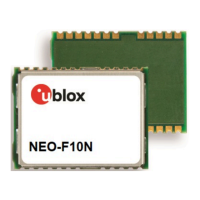NEO-F10N-Integration manual
radio systems. Estimation of the RF interference level coupled into the receiver antenna is a starting
point for RF front-end design.
For designs with other radio systems, the maximum power coupled into the antenna can be
estimated from the maximum transmission power and the isolation between the antennas.
Practical values for antenna isolation can range from 15–20 dB down to 6–10 dB for very small
devices. RF interference may also couple from external sources such as nearby mobile devices or
base stations.
A simplified test board can be used to estimate the isolation between two antennas. The size
of the board and the placement of the antennas must match the final design. Connect the RF
cables to the antenna inputs and measure S21 over the frequency band of interest with a vector
network analyzer (VNA).
RF interference from other parts of the design is more difficult to estimate. One option is to measure
the interference level at the receiver input using a spectrum analyzer. Interference within the design
is primarily a problem at the receiver in-band, where it cannot be addressed by filtering on the RF
path. Outside the GNSS band, the required filtering is determined by the estimated interference
level and the immunity of the receiver.
The maximum power coupled into the receiver RF input is compared against the immunity limit of
the receiver defined in Out-of-band blocking immunity.
4.2.4 Antenna power supply
Figure 6 shows an active antenna supply network to connect the antenna supply to the RF signal
line. The inductance L4 connects the antenna power supply to the RF signal line. The capacitance
C14 filters out high-frequency interference from the power supply and the resistor R8 limits the
short-circuit current.
The type and value of L4 is selected to have a resonance peak at GNSS frequencies. This provides
a high series impedance above 500 Ω at GNSS L1 and L5 frequencies, creating an impedance
mismatch with respect to the 50 Ω RF signal line. This minimizes the effect of the feed point on
the RF signal line, and isolates the antenna supply from the RF signal line at GNSS frequencies.
Both R8 and L4 must have sufficient current and power rating to withstand the short-circuit
current. Example component values for the antenna supply network are given in Standard resistors,
Standard capacitors, and Inductors.
The VCC_RF pin can be used to supply an active antenna. VCC_RF is a RF filtered supply voltage
derived from the VCC supply. Refer to the data sheet[1] for the VCC_RF specification.
The LNA_EN pin can be used to control the active antenna supply.
UBXDOC-963802114-12193 - R02
4 Hardware integration Page 23 of 42
C1-Public

